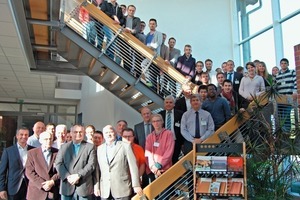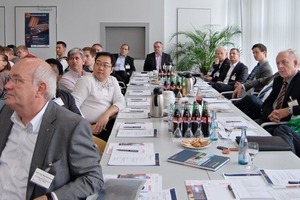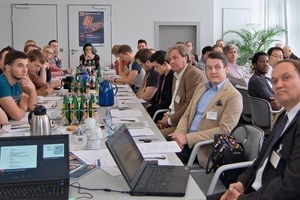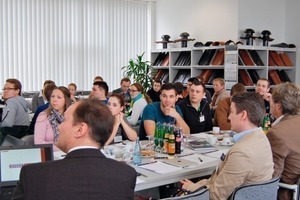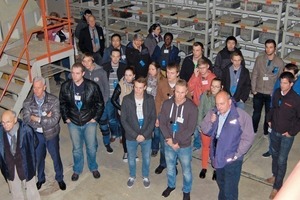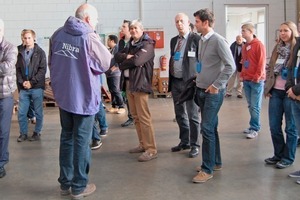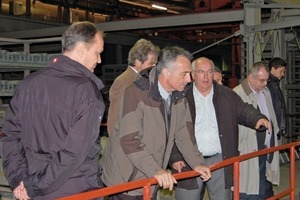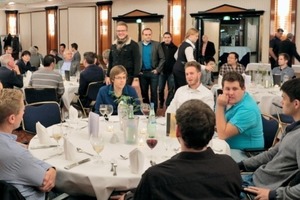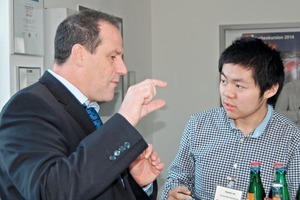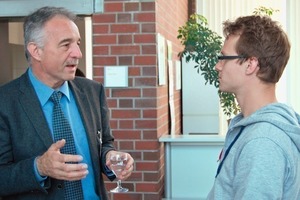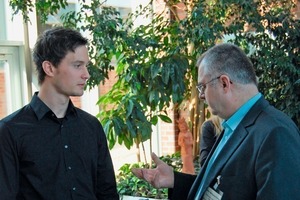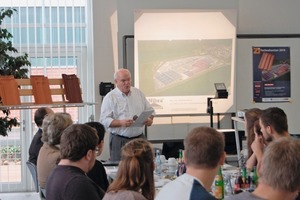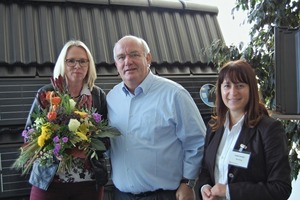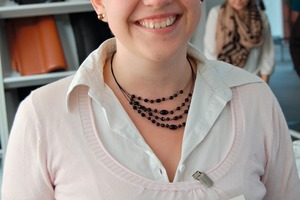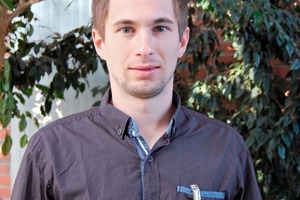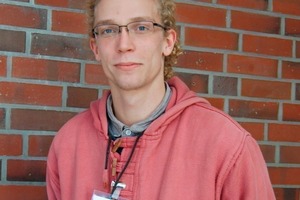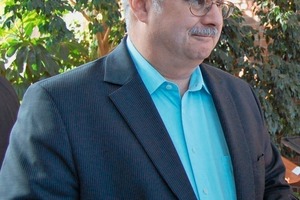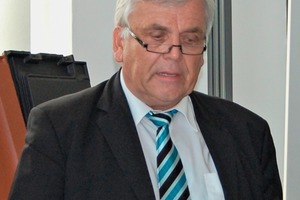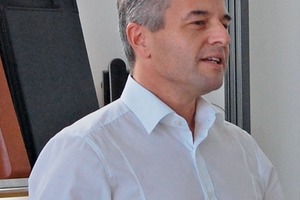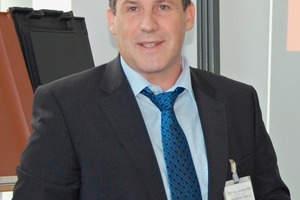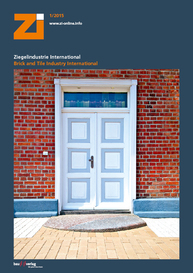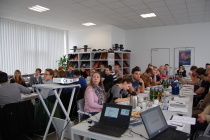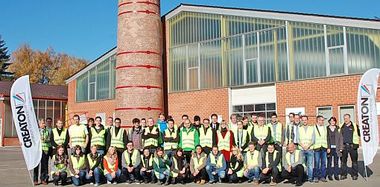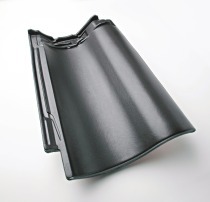Successful Zi field trip to a clay roofing tile plant
On 28/29 October 2014, the journal Zi Brick and Tile Industry International, supported by several sponsors, arranged a first field trip. 42 undergraduates/PhD students from three universities and their mentors visited the clay roofing tile manufacturer Dachziegelwerke Nelskamp, plant Nibra, to find out about state-of-the-art production technologies and discuss current issues in the industry.
The clay roofing tile plants Dachziegelwerke Nelskamp, plant Nibra, were the destination for the first Zi field trip. For the six sponsors
Händle GmbH Maschinen und Anlagenbau, Mühlacker
Keller HCW GmbH, Ibbenbüren
Dr. Krakow RohstoffConsult, Göttingen
Hans Lingl Anlagenbau und Verfahrenstechnik GmbH & Co. KG, Krumbach
Opavsky Emailleschmelze & Glasurenfabrikation Josef Opavsky und Sohn, owner Dipl.-Ing. (FH) Heinz Kropp GmbH, Vallendar
Refratechnik Ceramics GmbH, Melle
encouraging and supporting young professionals has become such an important part of their company policy that they gladly agreed to take part in the event organized by Zi Brick and Tile Industry International. Presenting one specialist paper each and an overview of their company, they informed the students not only about technologies in heavy clay ceramics, but also about opportunities for joining their companies and possibilities for development within them.
Some of the students and their tutors had started out very early in the morning in order to attend the field trip. There had been huge interest from the universities in advance, unfortunately only a limited number of spaces were available. The attendees came from
the Georg Simon Ohm University of Technology in Nuremberg, Department of Materials Engineering, under the direction of Prof. Dr. rer. nat. Wolfgang Krcmar
Koblenz University of Applied Sciences, WesterWaldCampus, Department of Materials Engineering – Glass and Ceramics, under the direction of Prof. Dr.-Ing. Christian Schäffer
Otto von Guericke University of Magdeburg, Department of Process and System Engineering, under the direction of Prof. Dr.-Ing. Eckehard Specht
Manfred Bracht, Managing Director at Dachziegelwerke Nelskamp GmbH, had responded with an emphatic “Yes” to our enquiry whether we could hold the field trip at the Nibra plant. Our thanks therefore go to him and his dedicated team for their support. The generously sized training facilities at the plant provided a great framework for the event.
The Nibra philosophy
With this guiding mission, Manfred Bracht opened the presentations and provided an introduction to the brickworks in Gross Ammensleben.
Before the opening of this plant, the format sizes for concrete roofing tiles were around 10 tiles/m² and that of the clay roofing tiles usually 14 tiles/m². Manfred Bracht wanted to change that and produce large-size clay tiles. With the opening of the plant in 1995 on a greenfield site, without its own raw materials supply, he met with a great deal of incomprehension in the industry. But the idea of supplying the plant with clays from the Westerwald region via Germany’s Midland Canal worked out well. For around 20 years now, around 300 000 t/p.a. clay are shipped to Gross Ammensleben, that is one barge each day. The Westerwald clays with their high bending strength and their low water absorption are ideally suited for the production of high-quality, large-size roofing tiles and therefore the plant developed a roofing tile with 8 tiles/m². To be successful nationwide too, it was necessary for Dachziegelwerke Nelskamp to integrate the roofing tile plant Nibra in 1998. With the “Nibra DS 5” large-size moveable tile, of which just under 6 tiles/m² are needed, one of the biggest roofing tiles in the world is produced in Plant 2. Advantages compared to conventional coverings are, as Bracht claims, a lower weight on the roof and the possibility of working with wider batten spacing, which enables faster covering. One of the last development highlights from Nibra is a combined module for power and heat. In contrast to the solar systems mounted on top of the roof, the combined modules blend harmoniously into the roofscape. Carrier is the large-format “Nibra MS 5” clay roofing tile, which was specially developed for integration of the solar elements.
Challenge of producing large-size roofing tiles
Markus Jüchter, head of Project Planning at Keller HCW, began his presentation by describing the extensive range of opportunities available to both students and graduates at Keller HCW. Keller HCW cultivates close contact to various educational institutes.
Then he profiled the Nibra plant built by Keller with reference to Plant 2, in which seven different large-size roofing tiles are produced. Jüchter explained the different technological steps and the solutions realized for each. Special details include the special system for conveying the clay slugs and the robot handling of the clay slugs and green tiles at the roofing tile presses, drying frames with special transport and turning device to ensure precision, high availability and product quality. The vertical conveyors for loading the dryer cars were designed so that the tiles can be turned when, for example, air has to be blown onto the other side of the clay roofing tiles. Dryer car storage ensures that the wet side and dryer car unloading are separate from each other, enabling one or the other side to continue working for a certain time in the event of a problem. This also applies to the kiln car storage. Other highlights of the plant are the Keller jet-wall tunnel dryer (drying time 12 h) and the Keller tunnel kiln in which the clay roofing tiles are fired in around 9 h.
Plant tour
In an extensive tour of the plant, the students learned about the modern tile plant with its two production sites: from delivery and storage of the raw materials through preparation, shaping to handling, drying, firing and packing. The spaciously set-out site impresses not only with its ultramodern technology, but also with its cleanness. A particular highlight was the two Nova II six-field revolver presses in which the large-size tiles are formed in two fields. The clay bats are pre-pressed with a defined profile. For some students it was their first visit to a clay roofing tile plant – the response was correspondingly enthusiastic. With this practical knowledge, recapping the preceding presentation became a lot easier for many of the attendees.
Modern press-shaping based on the example of large-size roofing tiles
In a joint paper, Andreas Bergler and Sven Bayrl, Händle GmbH Maschinen und Anlagenbau, presented first the Nova II revolver press. This was specially developed and manufactured for the Nibra plant, to press large-size clay roofing tiles. It operates at 18 cycles/minute. The components of the 400-t press were given defined ribbing to optimally support the loads and guarantee a rigid structure. Key feature of the press is that the freely programmable press curves can be quickly adapted to the new product if a format change is needed.
In the second part, the students received information on the company and the opportunities for joining Händle. Thanks to the company’s alliance with its US parent Steele, many opportunities are available. One example given was the work of a plant student, who has completed his thesis in the scope of the Händle-Steele collaboration in the USA.
Get-together
The joint evening function on the first day was an opportunity for everyone to get to know each other better and make initial contacts. The sponsors and the students took the opportunity to talk about bachelor dissertations and master theses and starting professional careers.
Energy-optimized tile production
The advantages of a family-run business with short decision-making processes and flat hierarchies were presented clearly by Harald Gruber, Hans Lingl Anlagenbau und Verfahrenstechnik GmbH & Co. KG, who emphasized that process engineering occupied a central position at Lingl. The Head of Human Resources gave the students some useful information and advised them on human resources policy and career planning in a company whose employees have an average of 20 years service.
In the technical part, Manuel Bürzle focussed on energy efficiency in his talk and showed potential energy savings. These can lie in raw material optimization, the decoupling of dryer and kiln but also in demand-driven control of the dryer. The utilization of waste heat by means of heat pumps, e.g. from the dryer, is one possibility for optimization. The maxim here is: avoid – reduce – recycle.
Development of lightweight, energy-saving refractories
Klaus-Martin Meier, Refratechnik Ceramics GmbH, informed the students about his company with its around 1 600 employees and more than 120 years of experience in the field of ceramics. Refratechnik has five development centres that offer good career prospects. Advantages of the owner-managed family business were, he said, its long-term orientation, wide areas of responsibility and short decision-making processes.
In the technical section, his colleague Joachim Dörr went into the development and manufacture of H-setters. The H-setters used in the Nibra plant are designed as reversible setters so that the different models can be fired on them. Some of them have been in circulation for 12 years. Goal of a development is, even when a wide variety of products is manufactured, to fire all products on just one type of setter. In the development of the setters, state-of-the-art techniques, e.g. FEM design, were used.
Possibilities for the surface design of roofing tiles – from development to production
The long-established enamel and glaze manufacturer Emailleschmelze & Glasurenfabrikation Opavsky was presented by Hans Otto Ströder. The company produces frits, glazes, engobes and enamels from its own smelting operation with four rotary kilns – this guarantees high and consistent quality as well as a fast response. Ströder described to the students the development of a roofing tile glaze from the customer idea to the finished product. He emphasized that the requirements for engobed/glazed roofing tiles have risen enormously in recent years, and then he went into the key factors influencing glaze development, such as the preparation equipment used in the plant, the firing temperature, the coefficient of thermal expansion of the ceramic body, the kiln cycle time, etc.
To conclude, Ströder emphasized that the hierarchies at Opavsky are flat. As a production manager in a relatively small company, he was responsible for a lot of things and had to make a wide range of decisions. Ströder invited interested students to give him a ring and make an appointment with him.
Cost-optimized use of of raw materials
while maintaining constant product quality
Dr. Lutz Krakow, Dr. Krakow RohstoffConsult, introduced the last talk at the event with a basic definition and explanations of the clay minerals and their formation as a result of weathering. As clays are finite resources, the clay brick and tile industry has to look around for alternatives, also with regard to resource efficiency. Dr. Krakow sees his task in supporting the industry with the partial substitution of clays with suitable clay substitutes (waste materials). Most brickworks already work today with a combination of their own raw materials and externally sourced clays. Shale clays, sands from gravel washing and similar were for many a low-cost alternative, in respect of improving properties and sometimes also the price. Dr. Krakow presented materials that are well suited to body optimization in the clay brick and tile industry with reference to specific examples.
He stressed that his engineering office with around ten employees is always on the lookout for well-qualified professionals.
Conclusion
The event at the Roofing Tile plants Nelskamp, plant Nibra, met with great interest from the students. Many praised the possibility of being able to get together with potential employers and profit from their experience.
An evaluation of questionnaires on the event revealed that 75% of the students were very satisfied with the field trip and 25% satisfied. Particular praise came for the tour of the plant, which proved a highlight for many. 80% of the students were very satisfied with this and 20% satisfied. But the range of talks, which covered the entire spectrum of clay brick and tile production, was also well received. 60% rated the quality of the talks as very good and 40% as good. The topics addressed in the talks deepened the students’ knowledge. For the students it was particularly interesting that the speakers described their own development, showing how differently careers can turn out. The meeting of different universities was regarded as an enriching experience by the students, as this gave them the opportunity for discussions with each other. Besides listening to the technical talks, the students are very interested in obtaining even more information on training, employment and career opportunities in the different companies.
For the sponsors, the presentation of their companies and contact with the students was a good opportunity not only to meet future employees and form ties, but also to meet potential future customers.
Outlook
On the back of this positive feedback, we want to organize the field trip again in 2015, and we are planning on a date in November. Besides the ceramists and the process engineers, machine engineering students should also be taking part.
Are you interested in hosting the next student field trip at your brickworks or supporting the event as a sponsor? Then just ring Ingo Wanders (+49 5241 41973) and get him to take down your details!
Zi Ziegelindustrie International
www.zi-online.info

